推荐-从文化视角论商标的翻译 精品
- 格式:doc
- 大小:252.00 KB
- 文档页数:19
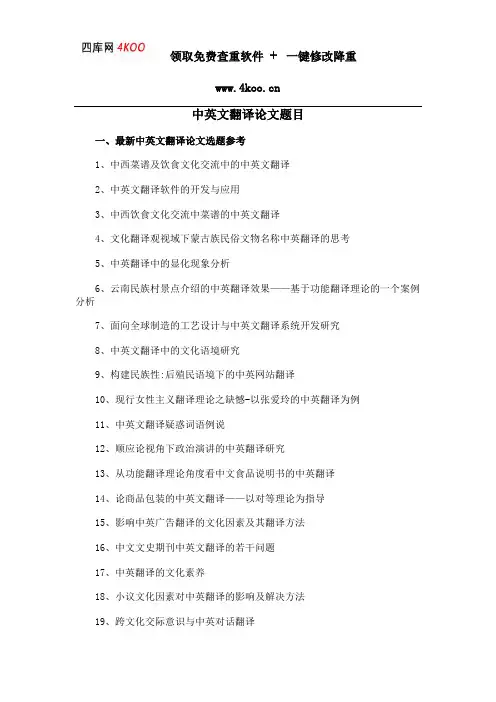
中英文翻译论文题目一、最新中英文翻译论文选题参考1、中西菜谱及饮食文化交流中的中英文翻译2、中英文翻译软件的开发与应用3、中西饮食文化交流中菜谱的中英文翻译4、文化翻译观视域下蒙古族民俗文物名称中英翻译的思考5、中英翻译中的显化现象分析6、云南民族村景点介绍的中英翻译效果——基于功能翻译理论的一个案例分析7、面向全球制造的工艺设计与中英文翻译系统开发研究8、中英文翻译中的文化语境研究9、构建民族性:后殖民语境下的中英网站翻译10、现行女性主义翻译理论之缺憾-以张爱玲的中英翻译为例11、中英文翻译疑惑词语例说12、顺应论视角下政治演讲的中英翻译研究13、从功能翻译理论角度看中文食品说明书的中英翻译14、论商品包装的中英文翻译——以对等理论为指导15、影响中英广告翻译的文化因素及其翻译方法16、中文文史期刊中英文翻译的若干问题17、中英翻译的文化素养18、小议文化因素对中英翻译的影响及解决方法19、跨文化交际意识与中英对话翻译20、中英语言翻译中的几种常见现象二、中英文翻译论文题目大全1、中英文翻译中的异化2、中英翻译中不同思维模式的转换3、中英翻译归化现象透视4、学术论文中英文翻译的不一致现象5、论中英人名翻译6、功能翻译理论角度的人力资源管理的中英翻译——以人事招聘与制度编制文本翻译为例7、“中华老字号”中英翻译存在的问题及策略研究8、北京地区高校校园标识语中英翻译调查研究9、从跨文化传播角度浅谈商标的中英文翻译10、数字出版中统计excel中英文翻译自动程序化的应用11、中西文化差异视角下的中英翻译12、“爱屋及乌”的中英翻译国俗语义差异13、从《毛选》英译看政治文献中英翻译的冗余度平衡14、景区标识语中英翻译实证研究15、中英字幕翻译中的文化差异及文化意象的处理策略16、论语法意识在中英翻译中的意义17、文化自觉与自信语境下的中英姓名翻译18、中西文化差异下的中英歌词翻译原则及方法19、从中西文化的差异性浅析中英翻译20、浅析电影作品里中英翻译所体现的文化差异三、热门中英文翻译专业论文题目推荐1、从功能理论视角谈旅游文本的中英翻译2、对九寨沟风景区标志牌中英文翻译的调查与建议3、浅析中英合同翻译语言层面上需要关注的几点要素4、论商品包装的中英文翻译—以对等理论问指导5、从文化交流层面谈中英文翻译时如何对待"异"与"同"6、以对等翻译理论指导商品包装的中英文翻译7、中英歌词翻译与文化传播8、中英文翻译中的文化空缺及翻译策略解析9、浅析谷歌翻译中英翻译的优缺点10、中英翻译问题剖析11、浅谈中英翻译比较12、红色在中英文翻译中的文化内涵与比较13、各种流行“族群”词语的中英文翻译14、中法文、中英文翻译中的文化“霸权主义”15、另辟蹊径,建立中英句子翻译结构新概念16、中英电影翻译中的文化意象17、中英翻译的不可译现象及译者处理对策--以《生死疲劳》葛浩文译本为例18、论《名利场》的语言艺术及其中英对照翻译19、我国公示语中英翻译研究概况20、英汉思维方式对比在中英翻译教学中的应用四、关于中英文翻译毕业论文题目1、动态顺应与中英人名翻译2、建构还是“解构”:中英大学翻译课教学模式之对比研究3、以中西文化差异探析中英歌词翻译4、武术中英翻译的现状及对策研究5、中英文翻译中文化空缺现象及翻译策略6、论海事英语中英文翻译7、基于Web的中英术语翻译获取方法研究8、中英文翻译视角转换浅议9、中英文化翻译: 当代中国文本译释个案研究10、跨文化翻译中的关联理论应用——以钱钟书《围城》中英翻译为例11、中英翻译课比较12、中国文学“走出去”的现状和前景——对2011中英翻译文学论坛的思考13、诺德功能模式个案分析:楼盘宣传册中英翻译14、中英翻译视角下的歇后语分类及其应用15、中英文翻译中文化空缺现象及翻译对策16、中英语言翻译中的不等同性17、中英翻译比较研究18、论商标中英文翻译的原则19、从红楼梦两个英译本看中英翻译的不可译性20、南阳市对外宣传公示语中英文翻译规范性调查与研究五、比较好写的中英文翻译论文题目1、中英歌曲翻译研究的现状及策略2、中英文化翻译中从不可译性到可译性3、试析关联理论在翻译中的应用——以旅游资料的中英翻译为例4、中英文翻译中的文化忠实与叛逆研究5、旧金山汉语桥比赛将举行中英文翻译或成最难考题6、浅谈文化差异视角下的中英翻译7、浅谈中英翻译中颜色词的异同8、功能派翻译理论指导下的外宣中英翻译研究9、从功能翻译理论角度浅议公共标志中英翻译10、浅谈我国旅游景区有关的中英翻译11、日本书名的中英文翻译对比研究12、中英文翻译的现代教育方法13、一种实现网页中英文翻译的系统和方法14、中英词汇翻译不对等现象——从"红糖"的翻译谈起15、浅谈中英文翻译的技巧16、航海英语中英文翻译论谈——船长考证英语辅导教学体会17、文化因素对中英翻译的影响及处理18、对中英翻译中存在的文化差异的分析与研究19、政府工作报告中英翻译中的衔接手段对比研究20、文化语境在中英文翻译中的深刻影响。

论顺应理论在商标翻译中的应用本文以Verschueren的顺应理论为基础,探讨了商标词的翻译过程中,译者应该如何使译文对目标语的语言系统,以及对目标语消费者的民族文化特征等做出各种顺应。
标签:商标翻译顺应理论一、引言比利时国际语用学学会秘书长Verschueren在他的新著《understanding Pragmatics》(语用学新解)中从全新的角度理解和诠释语用学,提出了综观说和顺应论,这种语用学研究的新视角具有很强的解释力,可以用来解释许多语言现象,如语码转换、模糊语言、广告语言等。
该理论同样能够用以解释许多翻译现象,并有助于理解翻译实践中现有的原则和策略。
在顺应论的框架内,翻译的过程就是在跨文化交际中,在不同的意识程度下动态的在语言结构和语境之间作出顺应的过程。
二、顺应理论在商标翻译中的应用语言是文化的载体。
商标的翻译者和接受者之间在形式上传递的是商品信息,实质上传递的是一种文化信息。
正如美国著名翻译理论家奈达(Nida.E.A)指出:对于真正成功的翻译而言,熟悉两种文化甚至比掌握两种语言更重要,因为词语只有在其作用的文化背景中才具有意义。
商标翻译必须符合目标语文化的接受要求,顺应该文化语境中受众的文化心理特征、表达习惯和审美心理。
1.顺应目标语的语言系统中英文两种语言系统有很大的区别,具体表现在音位、词汇、句法及语篇等各个层面。
而且由于不同的文化心理背景,相同的词在不同的文化中可能引起不同的联想。
因此商标词及其翻译首先应该在音的方面尽量避免使用那些拗口、能够产生歧义或引起负面联想的词语。
例如:饮料Sprite英文含义是“小精灵”或“调皮鬼”的意思,饮料初次出现在香港市场上时,根据港澳取吉利心理的常规,按其谐音取名为“事必利”,实际销售情况并不好。
而译为“雪碧”,从名字上就给人一种清凉爽口的感觉,充分表达出了该产品的特性,产品也随之为消费者接受。
同样商标汉译英时也应遵循这一规律。
如,中国的金鸡闹钟,它的译名Golden Cock就损害了商品在消费者心中的形象。
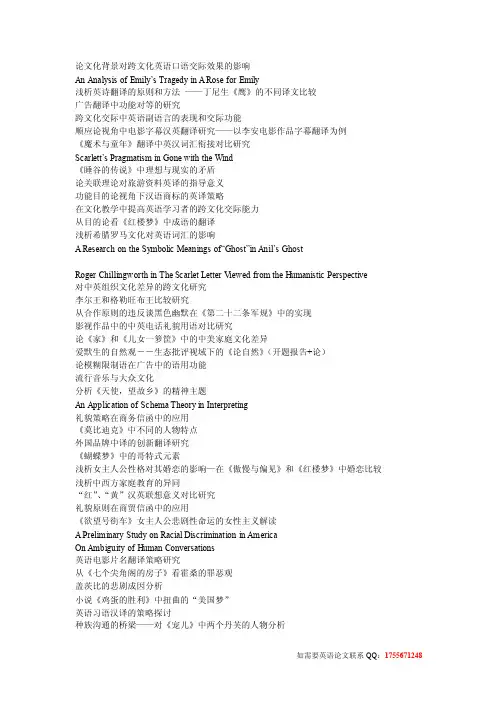
论文化背景对跨文化英语口语交际效果的影响An Analysis of Emily’s Tragedy in A Rose for Emily浅析英诗翻译的原则和方法——丁尼生《鹰》的不同译文比较广告翻译中功能对等的研究跨文化交际中英语副语言的表现和交际功能顺应论视角中电影字幕汉英翻译研究——以李安电影作品字幕翻译为例《魔术与童年》翻译中英汉词汇衔接对比研究Scarlett’s Pragmatism in Gone with the Wind《睡谷的传说》中理想与现实的矛盾论关联理论对旅游资料英译的指导意义功能目的论视角下汉语商标的英译策略在文化教学中提高英语学习者的跨文化交际能力从目的论看《红楼梦》中成语的翻译浅析希腊罗马文化对英语词汇的影响A Research on the Symbolic Meanings of“Ghost”in Anil’s GhostRoger Chillingworth in The Scarlet Letter V iewed from the Humanistic Perspective对中英组织文化差异的跨文化研究李尔王和格勒旺布王比较研究从合作原则的违反谈黑色幽默在《第二十二条军规》中的实现影视作品中的中英电话礼貌用语对比研究论《家》和《儿女一箩筐》中的中美家庭文化差异爱默生的自然观--生态批评视域下的《论自然》(开题报告+论)论模糊限制语在广告中的语用功能流行音乐与大众文化分析《天使,望故乡》的精神主题An Application of Schema Theory in Interpreting礼貌策略在商务信函中的应用《莫比迪克》中不同的人物特点外国品牌中译的创新翻译研究《蝴蝶梦》中的哥特式元素浅析女主人公性格对其婚恋的影响—在《傲慢与偏见》和《红楼梦》中婚恋比较浅析中西方家庭教育的异同“红”、“黄”汉英联想意义对比研究礼貌原则在商贸信函中的应用《欲望号街车》女主人公悲剧性命运的女性主义解读A Preliminary Study on Racial Discrimination in AmericaOn Ambiguity of Human Conversations英语电影片名翻译策略研究从《七个尖角阁的房子》看霍桑的罪恶观盖茨比的悲剧成因分析小说《鸡蛋的胜利》中扭曲的“美国梦”英语习语汉译的策略探讨种族沟通的桥梁——对《宠儿》中两个丹芙的人物分析从麦琪的礼物中折射出欧亨利对已故妻子的爱论直译与意译在英汉翻译中的应用认识、寻找和实现自我价值——剖析《飘》中的人生价值美国情景喜剧《老友记》中幽默的翻译研究英语动物习语的研究及翻译卡森•麦卡勒斯《心是孤独的猎手》福柯式解读德伯家的苔丝中苔丝的悲剧成因分析从《生活大爆炸》看美剧字幕翻译的文化转向解读《拉帕希尼的女儿》中的父爱女性主义的觉醒:论凯特•肖班的《觉醒》中英文商标翻译的问题及其解决方法论英语语言中的性别歧视现象她们的自我选择—解读简奥斯汀傲慢与偏见中女性的婚恋观A Popular Form of Subtitles Translation by Fansub Group on the InternetError Analysis on English Writing by Senior High School Students英文电影片名翻译的归化与异化课外作业对高中英语学习的作用研究《加里波利的坟墓》的反讽与对话The French Revolution in the Novel A Tale of Two Cities论《紫色》的叙事现代性分析查尔斯狄更斯《远大前程》的自传性分析浅析卡夫卡《变形记》中的异化现象论《被遗弃的韦瑟罗尔奶奶》中象征主义和意识流的运用Cultural Conflicts in Daisy Miller—An Analysis on Henry James’ International Theme 英汉颜色词的文化象征意义及翻译浅析《最蓝的眼睛》中的叙事艺术文化视野下的中美家庭教育方法的比较(英语系经贸英语)国外对华“双反”的现状、原因及对策研究全球商务中基于文化差异的品牌名称翻译初中英语教师提问策略对课堂师生互动的影响《等待野蛮人》中的寓言式写作手法《希腊古瓮颂》中的艺术和永恒之美论《傲慢与偏见》中的妇女地位问题论童话《小王子》的象征创作从功能派目的论角度看商品说明书的英汉翻译试析《老人与海》的悲喜色彩A Study of Narrative Techniques in Barn Burning中美电子商务的选择性分析On the Conflicts Reflected in the Character of Holden in The Catcher in the Rye英语广告的批评性话语分析英语听力理解障碍及应对策略《红楼梦》杨霍两译本建筑名比较论新历史主义视角下的《在美国》跨文化商务活动中的交际与礼仪中学英语口语教学中的互动英汉双语词典中的语用信息浅析中美婚礼习俗差异试论英语中的歧义与翻译A Comparative Study on Metaphors of FIRE between English and Chinese from a Cognitive Perspective翻译中的性别--《简•爱》几个中译本的女性主义解读论商业广告中的翻译对等原则浅析眼神交流在非语言交际中的作用中美婚姻价值观对比翻译的对等性研究及其应用论苔丝悲剧的成因中西礼仪对比浅探篮球文化的理论构建论《睡谷传奇》中的幽默元素美国文学中的美国梦研究企业网络营销策略分析中学英语教学大纲与课程标准的比较研究哈克贝里·费恩与汤姆·索亚性格的对比分析A Chinese-English Translation of Public Signs Based on Nida's Fuctional Equivalence Theory试析《生死疲劳》英文版风格之再现:文学文体学视角用会话含义理论分析《傲慢与偏见》中的人物对白关联理论关照下文化缺省现象及其翻译应对策略《纯真年代》中的女性主义象征主义手法在《白鲸》中的运用英语语言中的性别差异研究文化负迁移对翻译的影响A Research on Frances Burnett’s “Fauntleroy” Writing StyleOn the Combination of Romanticism and Realism in John Keats’s Poems海明威的女性主义思想《威尼斯商人》中的人物夏洛克性格分析读者与作者的断裂——多丽丝•莱辛《金色笔记》中的女权主义解读广告英语的特色与翻译技巧Application of Politeness Principle in Top Talk浅析构词法及其在英语词汇教学中的运用谈西方婚姻文化对当代中国女性婚姻观的影响目的论指导下的旅游资料汉英翻译及翻译策略从功能对等理论看政治文献中中国特色词汇翻译《加里波利的坟墓》的反讽与对话论《爱玛》中简奥斯丁的社会理想E-C Translation of Adverbial Clauses in Business Contracts from the Perspective of Functional Equivalence计算机辅助教学在英语教学中的作用《尤利西斯》与《春之声》中意识流手法的不同迷失的童年——从成长小说的角度解读伊恩•麦克尤恩的《蝴蝶》英语学习的性别差异及相应的学习策略情景教学法在中学英语写作教学中的应用《推销员之死》中的家庭问题研究英语专业学生英语口语学习动机调查研究夏洛蒂•勃朗特《简•爱》中普通而独特的女性形象目的论与外国汽车商标的汉译矛盾的女性主义观—读乔治.艾略特的《弗罗斯河上的磨房》浴火凤凰——美国黑人作家眼中的黑人生活从违反合作原则的角度解读会话含义文化杂糅背景下的身份诉求——解读奈保尔的《半生》浅析造成盖茨比悲剧的因素《辛德勒名单》主人公性格分析海斯特—《红字》中一位具有反叛精神的女英雄乌托邦和老子道家思想的比较研究英汉色彩词的语用对比研究The Study of English Film Title Translation Methods and Some Requirements to the Translators 傅东华译《飘》归化现象浅析中西礼貌用语的语用对比研究浅谈英语复杂句的翻译从社会符号学角度浅谈汉语“一”字成语翻译红色,英汉词汇差异的文化理据Confucianism’s Influence on Transcendentalism:Reflection on Emerson’s and Thoreau’s Philosophy比较《百万英镑》和《阿Q正传》中美两国女性在家庭和社会中地位的比较(英语系经贸英语)论苹果公司的撇脂定价策略安妮赖斯小说《夜访吸血鬼》的新哥特世界论商务英语广告的语言特征浅析叶芝诗歌中的象征主义特征An Analysis of Hemingway' Religious Complex in The Old Man and the Sea《洛丽塔》悲剧结局因素探析从跨文化的视角分析美国动画“辛普森一家”中的习语现象《红字》中替罪羊形象的分析从到《到灯塔去》的主要角色浅析弗吉尼亚.伍尔夫的女性主义思想英语课堂焦虑对小学生英语学习的影响及解决策略浅谈企业形象广告设计浅析爱尔兰诗人叶芝作品中的象征主义浅析以学生为中心的中学英语口语教学形合与意合对比研究及翻译策略Culture-oriented Strategies in Publicity Material Translation for Y angzhou City: a Perspective of FunctionalismThe Cultural Predicament and Transcendence: Methods of Translating the Allusion in News浅析霍桑罪恶观在《拉帕西尼的女儿》中的体现An Analysis of Tragic Consciousness in A Farewell to Arms乌鸦在中西文学作品中文化内涵的对比研究商务英语中的颜色词浅析迪斯尼动画《木兰》中的中美文化融合分析谈双关语的翻译论英语小说中俚语的汉译对《野性的呼唤》中的狗——巴克的分析研究《老人与海》和《白鲸》的生态意识对比A Study of Intertextuality in Advertising TextAnalysis of Social Condition from American Gold Rush in The Call of the Wild Strategies of V ocabulary Teaching in Middle School English Class论格列佛人物形象在《格列佛游记》中所起的讽刺效果高中英语写作前口语活动设计与实施建议论中西文化的差异对习语翻译的影响Analysis on Heathcliff's Personality in Wuthering Heights口译者听力环境的适应研究文化语境对翻译的影响英文电影名称汉译原则和方法的研究英语新闻中批评性语篇的对比分析从中西文化差异看文化负载词的翻译中外青年婚姻观念差异——从《柳堡的故事》和《傲慢与偏见》中进行对比苔丝悲剧人生的起因“eye”的认知分析中美学校教育和家庭教育之比较论《蝇王》中戈尔丁对人性之恶的解析浅析《飘》中女主人公的性格特征。
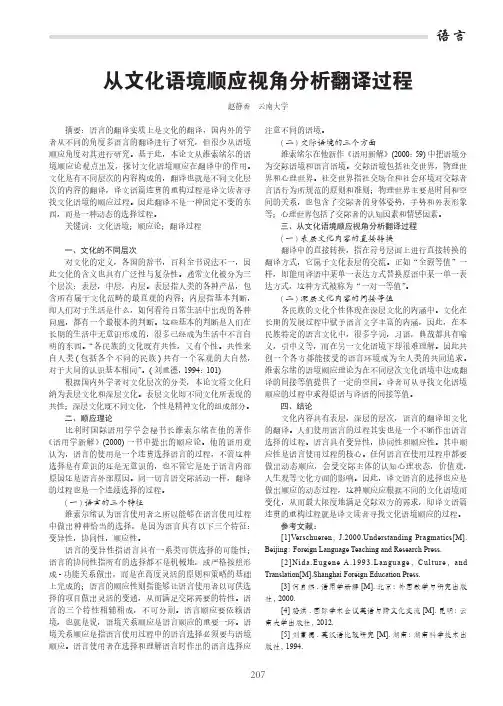
语言从文化语境顺应视角分析翻译过程赵静香 云南大学摘要:语言的翻译实质上是文化的翻译,国内外的学者从不同的角度多语言的翻译进行了研究,但很少从语境顺应角度对其进行研究。
基于此,本论文从维索绪尔的语境顺应论观点出发,探讨文化语境顺应在翻译中的作用。
文化是有不同层次的内容构成的,翻译也就是不同文化层次的内容的翻译,译文语篇连贯的重构过程是译文读者寻找文化语境的顺应过程。
因此翻译不是一种固定不变的东西,而是一种动态的选择过程。
关键词:文化语境;顺应论;翻译过程一、文化的不同层次对文化的定义,各国的辞书,百科全书说法不一,因此文化的含义也具有广泛性与复杂性。
通常文化被分为三个层次:表层,中层,内层。
表层指人类的各种产品,包含所有属于文化范畴的最直观的内容;内层指基本判断,即人们对于生活是什么,如何看待日常生活中出现的各种问题,都有一个最根本的判断。
这些基本的判断是人们在长期的生活中无意识形成的,很多已经成为生活中不言自明的东西。
“各民族的文化既有共性,又有个性。
共性来自人类(包括各个不同的民族)共有一个客观的大自然,对于大局的认识基本相同”。
(刘重德, 1994:101)根据国内外学者对文化层次的分类,本论文将文化归纳为表层文化和深层文化。
表层文化即不同文化所表现的共性;深层文化既不同文化,个性是精神文化的组成部分。
二、顺应理论比利时国际语用学学会秘书长维索尔绪在他的著作《语用学新解》(2000)一书中提出的顺应论。
他的语用观认为,语言的使用是一个连贯选择语言的过程,不管这种选择是有意识的还是无意识的,也不管它是处于语言内部原因还是语言外部原因。
同一切言语交际活动一样,翻译的过程也是一个连续选择的过程。
(一)语言的三个特征维索尔绪认为语言使用者之所以能够在语言使用过程中做出种种恰当的选择,是因为语言具有以下三个特征:变异性,协同性,顺应性。
语言的变异性指语言具有一系类可供选择的可能性;语言的协同性指所有的选择都不是机械地,或严格按照形成-功能关系做出,而是在高度灵活的原则和策略的基础上完成的;语言的顺应性则指能够让语言使用者以可供选择的项目做出灵活的变通,从而满足交际需要的特性。
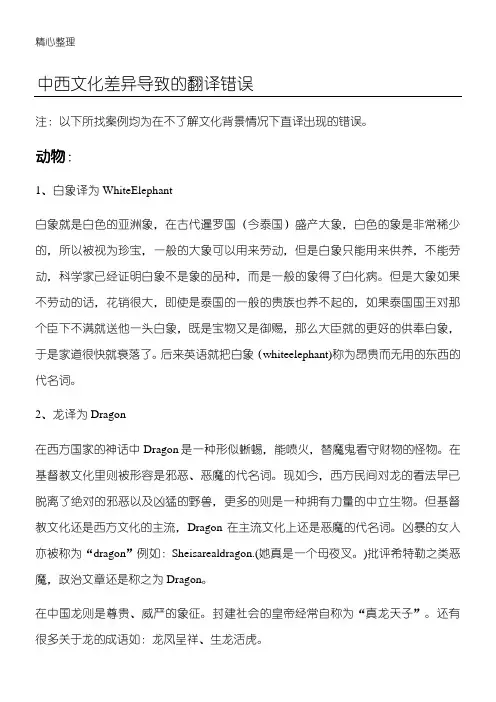
中西文化差异导致的翻译错误注:以下所找案例均为在不了解文化背景情况下直译出现的错误。
动物:1、白象译为WhiteElephant2、龙译为脱离了绝对的邪恶以及凶猛的野兽,更多的则是一种拥有力量的中立生物。
但基督教文化还是西方文化的主流,Dragon在主流文化上还是恶魔的代名词。
凶暴的女人亦被称为“dragon”例如:Sheisarealdragon.(她真是一个母夜叉。
)批评希特勒之类恶魔,政治文章还是称之为Dragon。
在中国龙则是尊贵、威严的象征。
封建社会的皇帝经常自称为“真龙天子”。
还有很多关于龙的成语如:龙凤呈祥、生龙活虎。
3、孔雀译为Peacock中国人认为孔雀开屏是喜庆吉祥的象征,所以人们常用孔雀比喻美丽的人或事物。
但是孔雀在西方的身价却一落千丈。
西方人认为孔雀行走时昂首阔步、目中无人,头冠频频摆动,还不时开屏来炫耀其美丽,这是"骄傲"、"虚荣"的表现。
TheAmericanHeritageDictionary对peacock的骄傲如孔雀4"蝠"crazyasabat发疯havebatsinthebelfry精神失常,行为乖张5、海燕译为Petrel在中国的文化中,海燕是搏击风浪勇敢的象征,但在西方人看了,海燕的出现就预示着暴风雨将要来临。
看见它就联想起“招致灾祸,带来纠纷”。
6、喜鹊译为Magpie在西方文化里,喜鹊的名声不太好。
它寓意着“爱饶舌、爱搬弄是非的人”和“爱储藏零七八碎物品的人”。
这些都属于贬义。
喜鹊由于它单调而又嘹亮的鸣声成为多嘴多舌的象征。
在奥维德的《变形记》中就记载,一位饶舌的妇人变成一只让人歧视的鹊。
但是在中国,喜鹊却象征着好运,人们相信它的叫声表示有好消息和有受欢迎7话中,Owl之说。
owl通8、羊译为羊在中国人的心目中具有吉祥、温顺、文雅、平和的美质,是五谷丰登、人畜两旺、国泰民安的象征。
在中国文化中,“绵羊”和“山羊”都是羊,并没有特殊喻意。
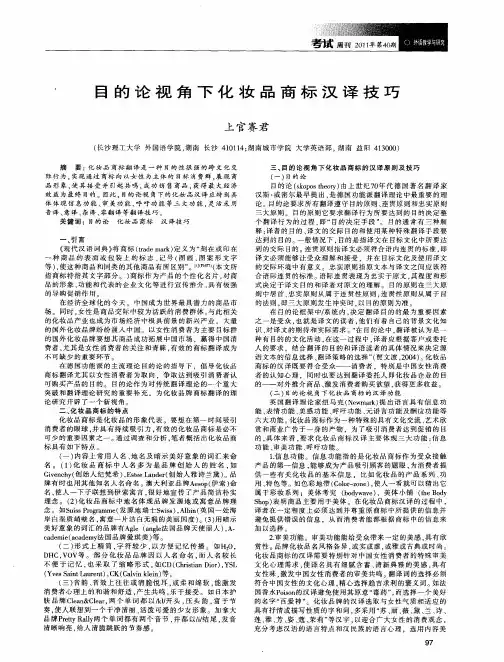
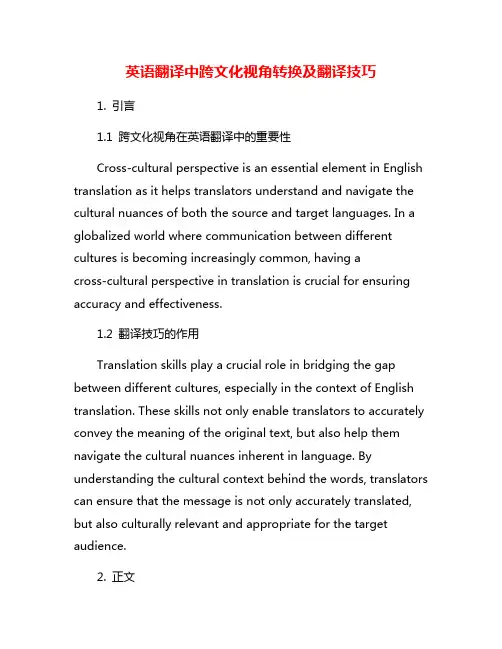
英语翻译中跨文化视角转换及翻译技巧1. 引言1.1 跨文化视角在英语翻译中的重要性Cross-cultural perspective is an essential element in English translation as it helps translators understand and navigate the cultural nuances of both the source and target languages. In a globalized world where communication between different cultures is becoming increasingly common, having across-cultural perspective in translation is crucial for ensuring accuracy and effectiveness.1.2 翻译技巧的作用Translation skills play a crucial role in bridging the gap between different cultures, especially in the context of English translation. These skills not only enable translators to accurately convey the meaning of the original text, but also help them navigate the cultural nuances inherent in language. By understanding the cultural context behind the words, translators can ensure that the message is not only accurately translated, but also culturally relevant and appropriate for the target audience.2. 正文2.1 文化背景对翻译的影响文化背景对翻译的影响是一个非常重要的因素。
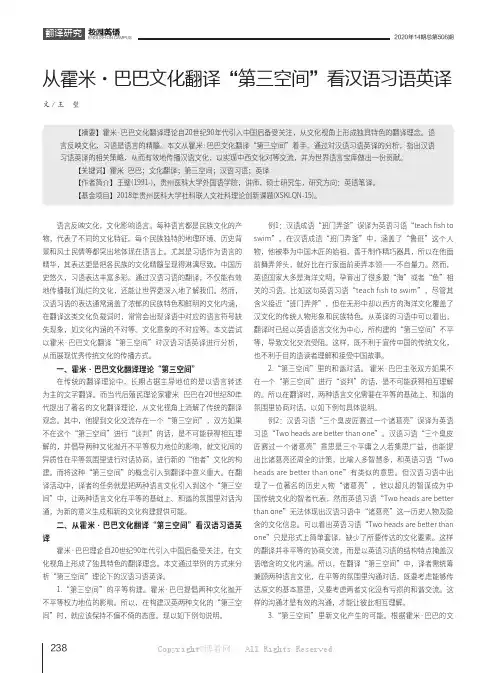
2382020年14期总第506期ENGLISH ON CAMPUS从霍米·巴巴文化翻译“第三空间”看汉语习语英译文/王 璧例1:汉语成语“班门弄釜”误译为英语习语“teach fish toswim”。
在汉语成语“班门弄釜”中,涵盖了“鲁班”这个人物,他被奉为中国木匠的始祖,善于制作精巧器具,所以在他面前舞弄斧头,就好比在行家面前卖弄本领——不自量力。
然而,英语国家大多是海洋文明,孕育出了很多跟“海”或者“鱼”相关的习语。
比如这句英语习语“teach fish to swim”,尽管其含义接近“班门弄斧”,但在无形中却以西方的海洋文化覆盖了汉文化的传统人物形象和民族特色。
从英译的习语中可以看出,翻译时已经以英语语言文化为中心,所构建的“第三空间”不平等,导致文化交流受阻。
这样,既不利于宣传中国的传统文化,也不利于目的语读者理解和接受中国故事。
2.“第三空间”里的和谐对话。
霍米·巴巴主张双方如果不在一个“第三空间”进行“谈判”的话,是不可能获得相互理解的。
所以在翻译时,两种语言文化需要在平等的基础上、和谐的氛围里协商对话。
以如下例句具体说明。
例2:汉语习语“三个臭皮匠赛过一个诸葛亮”误译为英语习语“Two heads are better than one”。
汉语习语“三个臭皮匠赛过一个诸葛亮”意思是三个平庸之人若集思广益,也能提出比诸葛亮还周全的计策,比喻人多智慧多,和英语习语“Two heads are better than one”有类似的意思。
但汉语习语中出现了一位著名的历史人物“诸葛亮”,他以超凡的智谋成为中国传统文化的智者代表,然而英语习语“Two heads are better than one”无法体现出汉语习语中“诸葛亮”这一历史人物及隐含的文化信息。
可以看出英语习语“Two heads are better than one”只是形式上简单套译,缺少了所要传达的文化要素。
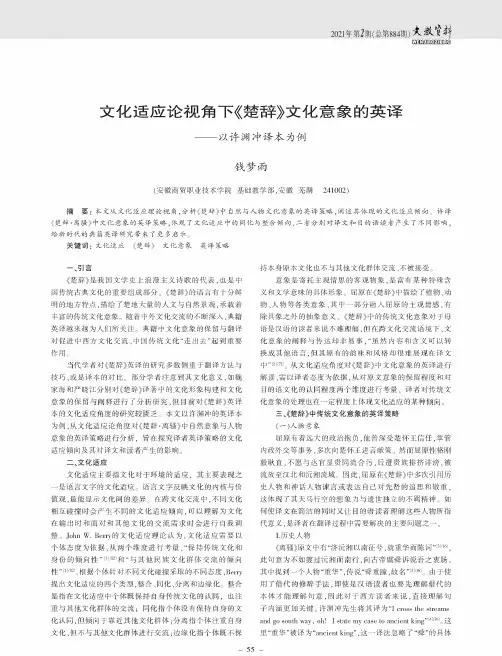
2021年第!期(总第884期)丈按%'科文化适应论视角下《楚辞》文化意象的英译----以许渊冲译本为例钱梦雨(安徽商贸职业技术学院基础教学部,安徽芜湖241002)摘要:本文从文化适应理论视角,分析《楚辞》中自然与人物文化意象的英译策略,阐述其体现的文化适应倾向。
许译《楚辞•离骚》中文化意象的英译策略,体现了文化适应中的同化与整合倾向,二者分别对译文和目的语读者产生了不同影响,给新时代的典籍英译研究带来了更多启示。
关键词:文化适应《楚辞》文化意象英译策略一、引言《楚辞》是我国文学史上浪漫主义诗歌的代表,也是中国传统古典文化的重要组成部分&《楚辞》的语言有十分鲜明的地方特点,描绘了楚地大量的人文与自然景观,承载着丰富的传统文化意象。
随着中外文化交流的不断深入,典籍英译越来越为人们所关注&典籍中文化意象的保留与翻译对促进中西方文化交流、中国传统文化“走出去”起到重要作用。
代学者对《楚辞》英译的研究多数侧重于翻译方法与技巧,或是译本的对比-部分学者注意到其文化意义,如魏家海和严晓江分别对《楚辞》译著中的文化形象构建和文化意象的保留与进了分,对《楚辞》英译本的文化的&文的英译为例,从文化适应论角度对《楚辞•离骚》中自然意象与人物意象的英译进分,译英译的文化适应倾向及其对译文和的影响-二、文化适应文化主要文化对的,主要一是语言文字的文化-语言文文化的与价值观,最能显示文化间的-在跨文化交流中,不同文化的文化,为文化在输出时和面对和其他文化的交流进行自我调整-JohnW.Berry的文化适应理论认为,文化适应需要以为依据,进行考量,“保持传统文化和身份的倾向性”112(82"和“与其他民族文化群体交流的倾向性”112(82)。
根据个体针对不同文化碰撞采取的不同态度,Berry 提出文化适应的四个类型,整合、同化、分离和边缘化-合是文化中既保自传统文化的,也注重与文化的交流;化没有保自的文化认同,但倾向于靠近文化群体;分离指个体注重自身文化,与文化进交流;边缘化既保持本身原本文化也不与其他文化群体交流、不被接受。
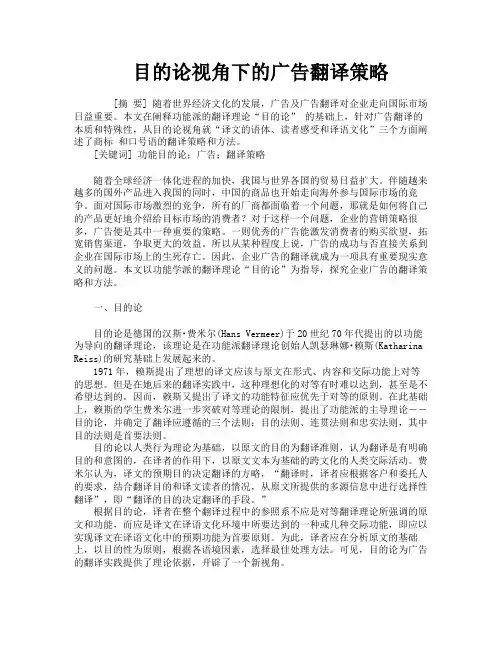
目的论视角下的广告翻译策略[摘要] 随着世界经济文化的发展,广告及广告翻译对企业走向国际市场日益重要。
本文在阐释功能派的翻译理论“目的论” 的基础上,针对广告翻译的本质和特殊性,从目的论视角就“译文的语体、读者感受和译语文化”三个方面阐述了商标和口号语的翻译策略和方法。
[关键词] 功能目的论;广告;翻译策略随着全球经济一体化进程的加快,我国与世界各国的贸易日益扩大。
伴随越来越多的国外产品进入我国的同时,中国的商品也开始走向海外参与国际市场的竞争。
面对国际市场激烈的竞争,所有的厂商都面临着一个问题,那就是如何将自己的产品更好地介绍给目标市场的消费者?对于这样一个问题,企业的营销策略很多,广告便是其中一种重要的策略。
一则优秀的广告能激发消费者的购买欲望,拓宽销售渠道,争取更大的效益。
所以从某种程度上说,广告的成功与否直接关系到企业在国际市场上的生死存亡。
因此,企业广告的翻译就成为一项具有重要现实意义的问题。
本文以功能学派的翻译理论“目的论”为指导,探究企业广告的翻译策略和方法。
一、目的论目的论是德国的汉斯・费米尔(Hans Vermeer)于20世纪70年代提出的以功能为导向的翻译理论,该理论是在功能派翻译理论创始人凯瑟琳娜・赖斯(Katharina Reiss)的研究基础上发展起来的。
1971年,赖斯提出了理想的译文应该与原文在形式、内容和交际功能上对等的思想。
但是在她后来的翻译实践中,这种理想化的对等有时难以达到,甚至是不希望达到的。
因而,赖斯又提出了译文的功能特征应优先于对等的原则。
在此基础上,赖斯的学生费米尔进一步突破对等理论的限制,提出了功能派的主导理论――目的论,并确定了翻译应遵循的三个法则:目的法则、连贯法则和忠实法则,其中目的法则是首要法则。
目的论以人类行为理论为基础,以原文的目的为翻译准则,认为翻译是有明确目的和意图的,在译者的作用下,以原文文本为基础的跨文化的人类交际活动。
费米尔认为,译文的预期目的决定翻译的方略,“翻译时,译者应根据客户和委托人的要求,结合翻译目的和译文读者的情况,从原文所提供的多源信息中进行选择性翻译”,即“翻译的目的决定翻译的手段。

目的论视角下的化妆品广告翻译探讨一、概述在全球化的今天,化妆品行业已经不再是单一的地域性市场,而是逐渐演变为一个全球性的产业。
随着国际贸易的日益频繁和消费者需求的多样化,化妆品广告翻译在跨文化传播中扮演着至关重要的角色。
化妆品广告翻译不仅要求语言准确、流畅,更要在文化层面上实现有效沟通,以吸引目标市场的消费者。
本文将从目的论视角出发,探讨化妆品广告翻译的原则、策略及其实践应用,以期为提高化妆品广告翻译的质量和效果提供有益的参考。
目的论是一种强调翻译目的和功能的翻译理论,它认为翻译是一种有目的的跨文化交际活动,翻译方法和策略的选择应服务于翻译目的的实现。
在化妆品广告翻译中,翻译的目的往往是为了吸引目标市场的消费者,传递产品的功效、特点和品牌形象。
翻译人员需要充分了解目标市场的文化背景、消费习惯和审美观念,采用适当的翻译策略,使译文在保持原广告信息的基础上,更符合目标市场的接受习惯,从而达到预期的传播效果。
通过对化妆品广告翻译的目的论视角探讨,我们可以更深入地理解化妆品广告翻译的本质和要求,为提升化妆品品牌的国际影响力和市场竞争力提供有益的启示。
同时,也有助于推动翻译理论在实际应用中的不断完善和发展。
1. 化妆品广告翻译的重要性在全球化日益加速的今天,化妆品广告翻译的重要性不容忽视。
化妆品行业作为一个全球性的产业,其市场推广和品牌建设往往需要通过翻译来实现跨文化的传播。
化妆品广告翻译不仅是语言层面的转换,更是文化、审美和消费心理等多个层面的交流与融合。
化妆品广告翻译对于品牌的国际化至关重要。
随着中国市场对外开放程度的不断提高,越来越多的国际化妆品品牌进入中国市场,同时,中国本土品牌也在积极寻求海外市场。
在这一过程中,广告翻译成为连接品牌与消费者之间的桥梁。
优秀的翻译能够准确传达品牌理念,展现产品特色,帮助品牌在目标市场中树立良好形象,提升竞争力。
化妆品广告翻译对于跨文化交流具有积极意义。
不同国家和地区的文化背景、审美观念和消费习惯存在差异,这些差异会对广告的效果产生影响。
跨文化视角下的翻译策略研究摘要:自从上世纪90 年代将文化研究纳入翻译研究的范畴里以来,从文化角度探讨翻译成为翻译研究的重要转向。
翻译不仅是从一种语言到另一种语言的转化,更是从一种文化到另一种文化的转化。
从跨文化角度研究翻译策略具有重要的意义。
关键词:跨文化翻译策略1 引言21世纪是一个商品社会和市场经济的世纪。
文化交流的背后是商业社会的利益驱动。
任何一种文化都不再是高高在上的,妥协是文化交流成功的必备因素之一。
跨文化翻译作为联系两种文化交流的目的,担负着文化传播的职责。
在这样的历史条件下,跨文化翻译的基本出发点就是要能以目标语受众能够接受的方式来进行。
翻译从本质上说不仅仅是语符表层指称意义的转换,更是两种不同文化的相互沟通,相互影响,相互理解。
从广义上来说,任何翻译都是跨文化的翻译,跨文化翻译指的是从翻译的角度对两种或多种不同的文化进行比较并且进行以文化交流和传播为目的的翻译。
作为翻译,我们面对的是外国的文化,这些文化里充满着文化独有的词汇、谚语、俗语等等地道的表达。
这些表达方式的渊源和使用是这些文化固有的。
跨文化交流成功与否,必须要取决于对外国文化的理解的程度。
而不同的译员又因为其翻译的目的而对文化采取了不同的态度。
有人认为译者应该以译出语为目标,有人认为译者应该以译入语中心,这样的争论必然也会使得跨文化的翻译变的多样化,同时也使得翻译的策略往往难以掌握。
[1]对于真正成功的翻译而言,熟悉两种文化甚至比掌握两种语言更为重要,因为词语只有在其作用的文化背景下才有意义。
不了解对方文化,翻译出来的只是语言;了解对方文化,才能翻译出符合对方文化需求的文章。
2 跨文化翻译的影响因素分析从跨文化角度解读翻译是全面认识和评价翻译的重要途径。
而同时值得注意的是从文化视角来研究翻译涉及到各方面复杂因素的影响。
2.1思维差异尽管生活在同一个世界,不同文化背景的人对待同一事情会有不同的方法。
普遍认为西方人的思维是分析的、逻辑而客观的,而中国人是综合、象征和主观的。
目的论视角下的文化负载词翻译标题中的「文化负载词」,特指寓含古代文化的繁杂复杂的词语,例如格言、成语、谚语等,它们几乎每个都包含了丰富的文化内涵。
而在翻译领域,这些古老语言带有文化负载的词语在进行翻译时具有不可忽略的重要性。
文化负载词的翻译,是指以原文文化特点和语言特色为基础,以新译语言对应的文化特点和语言特点为依据,以及考虑到文化沟通的要求,做出的翻译。
当今,由于技术的进步以及日益活跃的跨文化交流,越来越多的文化负载词被纳入翻译范围,这也对翻译人员要求更高。
以往翻译人员只会把文字类词汇进行翻译,而对文化负载词,常以直接意译或文字翻译来加以表达,这无论从句法表达上还是语义表达上都无法得到较准确的翻译效果。
因此,在翻译的过程中,需要借助于目的论来完成文化负载词的翻译。
目的论是一种翻译理论,认为在翻译过程中,句子的意义和结构都要根据目的语的语言习惯、语境、文化背景及重要信息等特点而调整,以达到艺术性和信息性的双重要求。
这便是目的论所指的---以求达到目标语言文化中最接近原文中所表达的意思。
针对文化负载词,目的论所提出的基本翻译方法,有意译、借用、改写等。
其中,意译也是文化负载词翻译中最常用的方法。
它是指在翻译文化负载词时,遵循翻译的目的使用新译文言语中的表意词语或结构,以表达原文中的文字或语义的含义。
其次是借用,它是指翻译者不改变原文的原意,但在翻译中尽量保留原文格式,并使用新文化的表达形式来表达原文中的含义,以满足读者的熟悉度和理解度。
改写则是指翻译者在翻译文化负载词时,可以根据目的语文化文化背景、文章结构及篇章位置等需要,对原文进行适当改写,以使其在新译文里呈现出更为恰当的表达。
但是,文化负载词翻译也存在着一些问题,如:由于文化负载词的复杂性,导致翻译时无法完全表达出原句的意思;翻译时还可能遇到文字上的误解、逻辑上的混乱或者句子长度和形式上的不同等问题,从而影响到翻译过程的有效性和准确性。
因此,有效地解决文化负载词翻译中的问题,除了要具备良好的文化意识、文学素养以及丰富的语言知识外,还应具备较强的创造性。
文化翻译视角下的外宣翻译作者:李梦婕来源:《青年与社会》2014年第21期【摘要】文章首先从文化翻译观的概念出发,阐述其对中国特色政治文化专有项翻译具有指导性。
再从文化翻译观映照下中国特色政治文化专有项的翻译原则,结合中国特色政治文化专有项在2008-2012年政府工作报告中的德译实例,探讨文化翻译观在当下外宣翻译中的重要作用。
【关键词】文化翻译;中国特色政治文化专有项的德译;政府工作报告外宣翻译运用目的语为语言介质翻译外宣材料,使源语国家信息在目的语国家得到传播,从而达到源语宣传主体的意图。
政治文献的翻译作为我国外宣翻译的客体之一,其中的中国特色政治文化专有项是外宣翻译的难点所在。
在当今各国文化交流亦更加频繁的时代背景下,中国特色政治文化专有项中所蕴含的丰富文化特征应得到更多的展示。
本文将从文化翻译观的视角出发,结合中国特色政治文化专有项的外宣德语翻译实例,阐释文化翻译观对政治文化专有项翻译的重要指导作用。
一、文化翻译观语言是文化的一部分,是体现文化内涵的载体。
就翻译与文化的关系,杨仕章先生已在其《略论翻译与文化的关系》中主要就语言语境外的诸多文化因素对翻译活动和过程的促进或干预的作用做了很好的阐述。
因此,翻译活动不能简单地看作是两种语言的转换,更是两种语言所涵盖文化的交流过程。
简单而言,文化翻译观提倡在翻译过程中保留源语文化信息。
中国特色政治文化专有项中所蕴含的许多鲜明的文化特质在目的语文化语境中是缺失的。
从文化翻译观的角度出发,这些信息是值得并需要保留的。
二、中国特色政治文化专有项的翻译原则本文根据艾克西拉对于文化专有项的定义,将政治文化专有项视为在源语意识形态、惯用法或使用频率等方面差异于目的语文化,从而具有不同文本地位的源语政治文化中的语言项目。
(一)采用“中国德语”对于政治外宣翻译中具有中国色彩的政治专有项,可按照文化翻译的观点,保留其文化特色,译为“中国德语”。
该提法是笔者从葛传槼先生在1980年首次提出“中国英语”(China English)这一概念转用而来。
目的论视角下国外化妆品品牌汉译策略研究*发布时间:2021-08-09T01:48:00.136Z 来源:《教育考试与评价》2021年第6期作者:唐丽君邓娅[导读] 不仅可以促进中西文化的交流,还可以促进相关产品的经济发展。
贵州财经大学,外语学院贵州贵阳 550025摘要:化妆品品牌的翻译是广告语中的一个重要组成部分,品牌作为一种特殊的文化活动,对于化妆品商品的促销起着关键作用。
本文先分析了化妆品品牌名称的语言特征,发现一些知名化妆品品牌的名称都具有音美、形美、意义深刻的特征。
然后从目的论的三原则(目的原则、连贯原则、忠实原则)探讨了化妆品品牌的具体翻译策略。
关键词:目的论;化妆品品牌;翻译策略On Chinese Translation Strategies of Foreign Beauty Brands from the Perspective of Skopos TheoryTang Lijun,Deng Ya(School of Foreign Languages, Guizhou University of Finance and Economics, Guiyang, Guizhou 550025)Abstract: The translation of cosmetic brands is an important part of advertising language. As a special cultural activity, brands play a key role in the promotion of beauty goods. This paper first analyzes the language features of beauty brand names, finding that the names of some famous beauty brands have the characteristics of beautiful sound, beautiful shape and profound meaning. Then, from the three principles of Skopos Theory (skopos principle, coherence principle and faithfulness principle), the specific translation strategies of beauty brands are discussed.Key Words: Skopos Theory; Beauty Brand; Translation Strategy一.前言随着经济的发展和人们生活水平的提高,人们在注重“内在美”的同时,也逐渐意识到外在形象的重要性。
“文化转向”视角下翻译学科的发展方向文化作为国家、民族所赋有的特征,通常受到所归属国家、民族和阶级的意识形态的影响。
在经济全球化时代背景下,尽管文化多样性有所提升,但传统的翻译过程无法完全使文化之间达到对等。
20世纪后半叶,伴随着文化研究在西方人文社会科学领域中的兴起,翻译也逐渐从过去囿于文本和语言的静态系统,开始向文化研究靠拢,在翻译研究中逐步突出和体现“文化转向”,翻译研究得以从纯语言的研究束缚中解放出来,并与文化研究紧密联合在一起,使翻译这门“边缘学科”走到了学术的中心,为翻译学科的发展带来了新的契机。
翻译研究“文化转向”的含义及特点翻译“文化转向”(Cultural Turn)意指翻译超越了文本和语言本身,尤其强调和关注译入语和原文化要素在翻译过程中的影响和制约作用以及翻译对文化的影响与促进作用。
其内涵在于关注社会、文化因素,以及意识形态对翻译行为的作用。
翻译的过程中,语言不再是重点,而是强调不同文化语境中的人类行为。
“文化转向”倡导将翻译放到文化大背景和社会语境之下考察,关注文化语境、历史规约等宏大背景,更为宏观地去描述翻译研究,最终将研究范围从纯语言层面扩展到文化层面。
据此,翻译“文化转向”的突出特点是将翻译过程看作宏观的文化转换。
相较于传统的翻译行为中斟酌“怎么译”的问题,翻译的“文化转向”则针对文化冲突解决了“不可译”的问题,并从译者主体性和译语所属文化层面对翻译进行研究。
这种边缘的、模糊的和开放的现状为翻译研究提供了进一步发挥的空间。
翻译“文化转向”还具有鲜明的时代特点。
在当代,高效的信息传播和各类媒体让经济全球化与文化之间关系紧密,其载体就是翻译。
首先,翻译“文化转向”摆脱了文字束缚,强调文化适应和文化交流,这使得翻译成为一种调适和创造的过程,有利于促进民族间的和谐与进步;其次,它还强调目的语文化的对等,使持不同语言的人群能进行平等的思想交流;最后,它关注目的语读者的情感,使得翻译能达到沟通思想情感、传播文化知识、促进社会文明的目的。
毕业论文院别外国语学院系别英语系专业英语(师范)年级20XX学生姓名程玉娟学号20XX24061436题目从文化视角论商标的翻译指导教师张琼完成时间20XX 年 5 月肇庆学院教务处制On the Translation of Trademark from theCultural PerspectiveA ThesisSubmitted to the School of Foreign Languages ofZhaoqing Universityin Partial Fulfillment of the Requirementsfor the Degree of Bachelor of ArtsByCheng YujuanSupervisor:Zhang QiongMay 20XXAbstractTrademark is one of the effective ways to help panies to spread their identities and better sell their modities. The paper discusses the international significance of trademark and the important effect of trademark translation that it can also be favored for a brand in the international market. Trademark is a symbol of representative product image and quality, with the specific cultural connotation. Trademark as a cross-cultural activity, there is a huge difference in Chinese and western language and culture, customs and tradition. The paper illustrates the monly used translation methods in the trademark translation, as well as analyses the main strategy of trademark translation on the influence of cultural difference. Finally on the question“how to make an accurate translation of China’s export brand name so that it can get the better sales goal”,this paper gives a further study.Key Words: trademark; culture; translation内容摘要商标是公司传播自身特点和促进销售量的有效途径。
商标的国际性的意义和商标的翻译对于一个商品品牌在国际市场上是否也能够得到青睐,也起着至关重要的作用。
商标是产品形象的代表和质量的象征,承载着特定的民族文化内涵。
作为一种跨文化活动,在中西方的语言文化、风俗习惯、传统等方面存在着巨大差异。
最后了商标的翻译中常用到的翻译方法:一般情况用音译的方法;根据商标所表达的意义、商标名称是否符合当地文化、商标名称对顾客的吸引性可选择意译,并分析文化差异对商标翻译的影响及商标翻译应把握的主要策略,探讨了如何准确翻译我国出口商品的商标名称,达到促进商品销售的目的。
关键词:商标;文化;翻译AcknowledgementsHere, I would like to express my sincere gratitude to all the people who have helped me finishing this paper. Especially I want to give my thanks to Ms. Zhang Qiong, my respected supervisor. Without her help, I am sure that I will not acplish this thesis successfully. Out of her busy work in the supervising, she helped me with revising my thesis. She read through my paper carefully and pointed the errors. With her careful revising, I finished my paper smoothly. In addition, I would like to express my thanks to the writers of the reference books. From them, I got so much useful materials.OutlineThesis Statement: This thesis analyses the translation methods of trademark from the cultural perspective.1.Introduction2. Culture Differences in the Trademark2.1 Thinking-pattern Differences2.2 Social Value Differences2.3 National Psychological Differences2.3.1National Values2.3.2 Religious Beliefs2.4 Aesthetic Interest Differences3. Translation of Trademark3.1 Transliteration3.2 Free Translation3.3 bination of Transliteration and Free Translation3.4 Effectiveness Translation4. ConclusionTable of Contents1Introduction (1)2 Culture Differences in the Trademark (2)2.1 Thinking-pattern Differences (2)2.2 Social Value Differences (3)2.3 National Psychological Differences (3)2.3.1 National Values (4)2.3.2 Religious Beliefs (5)2.4 Aesthetic Interest Differences (6)3 Translation of Trademark (7)3.1 Transliteration (7)3.2 Free Translation (8)3.3 bination of Transliteration and Free Translation (9)3.4 Effectiveness Translation (10)4 Conclusion (11)Bibliography (12)1. IntroductionTrademark is a symbol of a product in the form of one or more words (Oxford Dictionary of Business, Market House Book Ltd, 1990). It stands for the quality, function, after-sale services and other important traits of the product. And it is not only a logo, also a lure, the final goal which is to attract customers and sell modities. The translation of trademarks belongs to the field of business translation and also has its own distinguishing features. As stated by an American scholar, “A good translation of a brand name can bring millions of dollars’ difference in the product sells record.”(包惠南,20XX:28) With more and more foreign products came into China and Chinese products exported abroad, trademark translation has bee an increasingly significant part of marketing strategy. A well-translated trademark can also save millions of dollars over the product’s life because it carries its own meaning, describes the product’s advantages, and differentiates the product significantly from its petitors. By reading the trademarks, it is easy to tell the products from one to the other and to know the characters of products. For the good trademark has the functions of distinguishing, providing information of products and being symbol of credit, the good trademark has a good advertisement for the product and help to take in a larger market .So this paper emphatically point out the culture differences in trademark translation, if the translators know more about these differences, they may translate trademarks better.2. Culture Differences in the TrademarkThe trademark translation and cultural differences are inseparable. In social life, culture plays a vital role, which greatly affects people’s daily life. Cultural diversity decides people to have different ways of thinking, aesthetic temperament and interest, and national psychology as well as the social value in trademark translation. (Nida, Eugene, 20XX:27)Therefore, the translators must consider the influences of the cultural differences during the trademark translation. (陈炼,20XX:47)Now, I will discuss on the influences of the English trademark translation from the following four different kinds of cultural differences.2.1 Thinking-pattern DifferencesCountries all over the world have different geographic location, political system and racial system as well as economic development level. Besides, people in different culture background tend to have different ways of thinking. Now, let’s talk about the thinking-pattern differences. In Western countries, people often are used to getting the abstract way of thinking, however, Chinese are used to thinking in images. The essential difference between abstract thinking and thinking in image lies in using the different basic unit during the process of the thinking. Abstract thinking is the basic unit of the concept, and thinking in image is the basic unit of the perceptual image. The trademark translators should pay much attention to transfer from the abstract thinking to the thinking in image in English trademark translation into Chinese. Therefore, in some cases, many rather abstract English trademarks are translated into Chinese, which should be objectified in visualization. For example, English trademarks “Peps i Cola”, “Coca-Cola”, “Colgate”, and “Rejoice” are translated into Chinese words, separately for “百事可乐”;“可口可乐”; “高露洁”and “飘柔” They are not only specific image, but also can bring a person enjoyment. This way of translation considers that people from different countries have different thinking-pattern. These kinds of famous and successful trademarks have brought great benefits for businessmen.2.2 Social Value DifferencesEvery society and culture has its own social values. As a core of the system of culture, social value is an evaluation of things around him or her and also is the orientation to taking behavior. Social value is a person’s behavior direction and motivation. Therefore, the social values directly affect the consumption behaviors. As is known to all, the most important difference between Chinese culture and Western culture is that people have collectivism and individualistic attitudes. (詹欣珍,20XX:24)In Western culture, people strongly advocate individualism. They advocate personal struggle, enterprise and innovation. So the Western trademarks are named after the people who are the founders of relevant goods. However, in China, collectivism is advocated by people and plays a leading role in our society. It is also the criterion to identity people whether they own a sense of responsibility or not. Different social values play an important influence on the trademark translation. For example, English trademark “Budw eiser” is translated as “百威”, “GOME” is translated as “国美” and “Aiwa” is translated into “Love China”, and so on.2.3 National Psychological DifferencesThe national psychology refers to a character, temperament, emotion, value orientation and religious mentality of a nation. Even though a national psychologicalmodel and characteristic have something in mon with other nations’ psychological models and characteristics, mostly are reactive and different. National psychological differences enable people from different countries to have psychological impacts and form the obstacles in their association. So a national psychological mode will inevitably affect people shopping mentality. In the trademark translation process, if the translators ignore national psychological differences, even good products will not be accepted by people just because of the trademark names. National psychology contains national values and religious belief.2.3.1 National ValuesCultural value is to display the profound humanistic spirit through the “restraint”and “self-denial”. (李宝成,20XX:62)It advocates moral values that are self-cultivation and regulating the family as well as governing. Trademark also expresses this concept with its concise language. Chinese people in psychology are more willing to select the lucky words or connect the trademark name with nice wish through “谐音”. Trademark translation process is a process of renaming. So when English trademarks are translated, the translators should know that Chinese people have minds that are hastening lucky, avoiding disaster and blessing.Many importers pay much attention to Chinese culture and the national values during the translation so that they can open the China market for the products. The famous beverage “Coca-Cola”is translated as “可口可乐”, which caters to Chinese people “Great happiness, Great joy”psychology, brings the revenue for pany. Also, “Gold Lion” was translated as “金狮”originally, but “狮” in Hong Kong and Macao issimilar with the pronunciation “lose” so it sold block. Later, it is translated as “金利来”. The translator uses the free translation of “Gold”which is “金”, and adopts the transliteration of “Lion”that is “利来”. From then on, the profits of good are increasing rapidly because its name caters to Chinese people’s psychology. There is an example, BMW are acronyms of Bayerische Motoren Werke (Bavarian motor pany). When the product es to the Chinese market, the translator leaves out the last letter W and just translates two letters B and M as “宝马” according to Chinese two-syllable. The name enables BMW to contain rich Chinese culture.Chinese consumption mind is hastening lucky and making profits, paying attention to durability and efficiency, often expecting to be long, sure and real allowance and guarantee. When many English trademarks are translated into Chinese, the translators should pay much more attentions on Chinese consumers’ values and national psychology, such as “Seven-up”(七喜), “Gold Lion”(金利来), “Cannon”(佳能), “Dove”(德芙) (the homonyms of Chinese nice word “De Fu”). Chinese people would rather choose trademarks which represent good things not to choose trademarks with evil things.2.3.2 Religious BeliefsDifferent nations have different religious beliefs and different beliefs have different taboos. Understanding taboos has a very important significance in trademarks translation, because people’s religious beliefs in a large extent influence people’s consum ption idea and behavior. If the business ignores religious differences, products not only can’t open market, but also would be suppressive. For example, as the above mentioned “Gold Lion”(金利来) product, firstly it was translated into “金狮”so that it can’t open themarket in China. Because it suffers from “Buddhism” and “Taoism” and people pursue a long life. “Golden Lion”and “today death”are the same sound so that people will consider it is unlucky. And then it was translated as “金利来”, which is a good fortune. In addition, Chinese ethnic culture always pays attention to inside, steady and euphemism. One English trademark called “Kiss Me”, which wishes to express that it makes females more enchanting sexy. If a translator lacks Chinese culture, simply translated it was “吻我”, then its amount in the Chinese market is far from “奇士美”. 2.4 Aesthetic Interest DifferencesElegance is a kind of cultural characteristic that human being own. Vulgar trademarks can cause consumers disgusted. It may have this case that what is considered elegant in one culture may be vulgar in another one. Therefore, we have to understand different characteristics of cultures, like taboo and metaphor and so on. The aesthetic psychology is an important factor of social culture. The translators only cater to different national aesthetic psychology so as to give consumers a beautiful enjoyment and stimulate their purchasing desire. For example, a France famous perfume brand called “Poison”. It caters to Western women’s rebellious and personality. It is sold v ery well in Western countries. However, in China, people’s aesthetic interest is quite differe nt from Western. Eastern women are well-known as good morality and virtue. If the “Poison” is directly translated into “毒药”, for most Chinese women it is difficult to accept. Sales will well? Later, it is translated into “百爱神” to enter into Chinese market. It shows the other kinds of beauty which is different from the original one. In translation, national aesthetic interest differences should not be neglected. Take color as an example, Belgiumhate blue because they think blue is unlucky. In a word, the translators should know exactly about the other countries of culture and tradition so that products would be promoted well in the international market.3. Translation of TrademarkSpeaking of methods of translation, free translation, transliteration and bination of transliteration and free translation are always mentioned. (冯庆华,1998:35)In trademark translation, they are also in mon use. According to William Wells’ advertising book, he argues that it is particularly difficult for international panies to adapt to names and product slogans in Chinese. It can be seen then; translating foreign trademarks is really a hard nut to crack. To achieve the best effect, sometimes some special methods are also needed.3.1 TransliterationIn English trademark translation, transliteration is more mon used. It is the way in which the trademark is translated according to pronunciation of source language to show features of the moditie s so that it can deepen consumers’ impression and memo ry. (史玉娟,20XX:78)The purpose of such an approach is to ply with the linguistic rules and to convey the source language culture. And the strong point of using transliteration is that it can best preserve the rhyme of original trademark, reflecting the product’s special emotional appeal. Many trademarks are translated by this way.Different trademarks should find their own ways to use this method. The world famous Internet search engine Yahoo! Chinese name is “雅虎”, which is full of humorand wit so that it can attract the consumer’s eyes. “Tiger” stands for forces in Chinese minds and it also shows good lucks. The tiger is a king of beasts so it can show Yahoo! status among the Internet. “Elegance” also reflects a small tiger’s clever, lovely and eliminates a tiger’s ferociousness. For all, the trademark is more close to the consum ers and wins the love of consumers as well. There are also another examples, such as, “Casio”(卡西欧); “Audi”(奥迪); “Siemens”(西门子); “Sony”(索尼) and so on.Though this kind of translation can hardly associate the feature of the product with the name, they do follow some of the preconditions mentioned earlier in the paper like using characters with favorable meanings and making the translation short and fair-sounding. Take “IKEA” for instance, it is a famous furniture brand and its translation “宜家”makes use of the character “宜”meaning “appropriate for”and “家”meaning “home” to imply that the furniture are very appropriate for your home. Also, “宜家”is very easy to remember and sounds like its original brand very much.3.2 Free TranslationFree translation is according to the meaning of the trademark to translation. (范仲英,1994:49)The translators carefully choose words to create a beautiful conception for the consumers and also should express the utility of the products.Many successful trademarks translation have bee the pany’s vast wealth and intangible assets. For example, Hong Kong Gold Lion “金利来”(men’s clothing) has bee a world brand. “金利来” is popular with customers. The translator bines Gold “Gold, money, fame and fortune” and Lion “e”, so “金利来” means that money and fame will e to you. Therefore, it is the best choice to the successful men. “Microsoft”, the Americansoftware giant pany, also adopts the translation method to register its Chinese brand. Translating “Micro”as “Wei”and “soft”as “软”successfully transmits the implied meaning: basic, tiny and delicate software. There are some other examples, such as, Panda (熊猫)-TV; Crown (皇冠)-Car.3.3 bination of Transliteration and Free Translationbination of transliteration and free translation is a high skill which requests a firm basis and profuse imagination. Taking the pronunciation and the meaning of source language into consideration at the same time, bination of transliteration and free translation is a translation skill reflecting the traits of products. (章和开,王云桥,1997:78) It is the best skill having the best effect to translate the trademarks of mon products.“Dove”is a brand of daily modities and a trademark of chocolate. In English, it means “鸽子”, a kind of bird. Although this translation has nothing to do with these two products, it does have its significant connotation. (王向华,20XX:56) As a modity trademark translated as “多芬” has the meaning of soothing fragrance. However, as the trademark of chocolate, it is translated as “德芙” with the advertisement “milk fragrant, silky feel; silk smooth full-bodied, pure aftertaste”. Before you put it into your mouth, you can feel the thick milk fragrance. The two translations are more vivid and meaningful than pigeons. Another skin-protection creaming “Tobaby” is translated into Chinese “丹芭碧”which has nothing to do with the property of modity, but “丹”and “碧”will give people a beautiful enjoyment, arousing their association with skin and appearance.The United States Johnson & Johnson pany founded in 1887 is operating medical health care and care products. It was established by three brothers, namely, Robert Wood Johnson, James Wood Johnson and Edward Mead Johnson. If it is translated into “Johnson”(约翰逊) by the literal translation, it will not have any special differences. However, if the translator uses nearly sound and imagination method, it is translated as “Johnson& Johnson”(强生) with imaginations of strong vitality and connection of the pany’s health care and health care products. Let us e to another example. American Hewlett-Packard Co. is the world’s largest electronic instruments and small puter manufacturers. Its trademark is bining the names of two founders W﹒Hewlett and D﹒Packard. The abbreviation is “HP”, and it is translated into “HP”(惠普) which allows consumers to have an imagination of benefits and popularities.3.4 Effectiveness TranslationEffectiveness translation is also one of the trademark translation methods. It is a way that the trademark is translated by the effectiveness which the consumers may get or wish to get from this modity. (史玉娟,20XX:78) For example, a famous shampoo is named “head shoulder”, which it can make your hair smooth. If you buy and use it continuingly, you will have soft and beautiful hair. Therefore, it is translated as “海飞丝”in Chinese markets. One more example, it is “Safeguard”which is a kind of soap. According to the word “Safeguard”, it is not hard to know that it is a cleaner. Chinese name is “舒肤佳”. If you use it, there is no virus with you and you can always keep clean and have a wonderful mood. For all, “舒肤佳”is the best translation of “Safeguard”. Let's move to another brand. From the word “Rejoice”, we can know its meaning is cheerful. If it is translated by the skill of free translation, the result is not as good astranslating it into Chinese “飘柔”. By reading this name, it is easy to know that it is one kind of shampoo, which has the effectiveness of making hair soft and smooth. In a word, these cases are the best examples to show their effectiveness.4. ConclusionTo some extent, a trademark is more important than the product itself, which is a maxim western advertising designers generally accept and abide by. For words in different cultures have different cultural connotations, which arouses different association. People rack their brains to invent brands which are full of wit and humor, vividness and vigor, uniqueness and novelty, to give a deep impression to the consumers and triumphs over the opponents in keen petitions. Thus, brands are also special words in regards to their economic feature, with the basic function of distinguish products, providing information, symbols of credit and stimulating consumption.On the whole, the brands translation is a very important skill. When brands are being translated, the cultural differences should be considered and the information of products should be also paid attention to. Chinese and English are different languages with different cultures. The significance of researching on the brand translation in different cultures is to improve the insight of the using of languages and understand the source and target language pletely so that brands can get an equal effect in two languages. After a research on it, the foreign trading and cross-culture munication must be more effective and easier.Bibliography[1]Nida, nguage, Culture, and Translating[M].Shanghai:Shanghai Foreign language Education Press.[2] Tuck.1990.Oxford Dictionary of Business. Market House Book Ltd.[3] 陈炼.20XX.从中外文化差异看商标翻译[J].湖南商学院学报(1):47.[4] 冯庆华.1998.实用翻译教程[M].上海:上海外语教育出版社.[5] 范仲英.1994.实用翻译教程[M].北京:外语教学与研究出版社.[6] 黄瑞红.20XX.商标翻译的方法及应该遵循的基本原则[J].江南大学学报(6):73.[7] 华先发.2000.新实用英译汉教程[M].武汉:湖北教育出版社.[8] 李宝成.20XX.谈汉英商标翻译中的文化冲突现象[J].辽宁师专学报(3):62[9] 吕晔.20XX.商标的文化特征与翻译策略[J].淮阴师范学院学报(4):78.[10] 史玉娟.20XX.从文化差异看商标翻译的方法及原则[J].沈阳工程学院学报(1):78.[11] 王向华.20XX.商标翻译策略[D].山东:山东师范大学.[12] 章和开,王云桥.1997.英汉翻译技巧[M].北京:当代世界出版社.[13] 詹欣珍.20XX.英汉文化差异与商标的英译[J].闽西职业大学学报(4):24.[14] 朱亚军.20XX.商标名的翻译原则与策略[J].外语研究(6):31.。